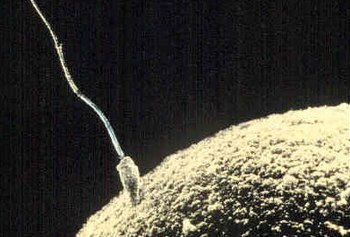Spermatozoan
| Spermatozoon | |
|---|---|

|
|

Diagram of a human spermatozoon
|
|
| Details | |
| Identifiers | |
| Latin | spermatozoon |
| MeSH | A05.360.490.890 |
| Dorlands /Elsevier |
Spermatozoa |
|
Anatomical terminology
[]
|
|
A spermatozoon (pronounced /ˌspɜːrmætəˈzoʊən/, alternate spelling spermatozoön; plural spermatozoa; from Ancient Greek: σπέρμα "seed" and Ancient Greek: ζῷον "living being") is a motile sperm cell, or moving form of the haploid cell that is the male gamete. A spermatozoon joins an ovum to form a zygote. (A zygote is a single cell, with a complete set of chromosomes, that normally develops into an embryo.)
Sperm cells contribute approximately half of the nuclear genetic information to the diploid offspring (excluding, in most cases, ). In mammals, the sex of the offspring is determined by the sperm cell: a spermatozoon bearing a X chromosome will lead to a female (XX) offspring, while one bearing a Y chromosome will lead to a male (XY) offspring. Sperm cells were first observed by Anton van Leeuwenhoek in 1677.
...
Wikipedia
